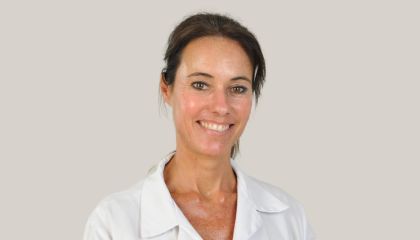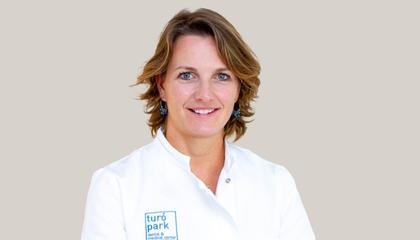
Article on menopause Turó Park Clinics
By :
Dr. Celia Marcos Gynaecologist, specialist in Menopause and Hormone Therapy
Cathy Morguese Integrative Nutrition Therapist.
Objective:
- To provide information on the menopause transition period, which occurs around the age of 50.
- Present solutions in terms of nutrition, hormones and supplements for a smooth transition.
- Understand what has changed in recent years in the approach to this important phase in a woman's life.
What is the definition of menopause?
Menopause is the time when the ovaries stop functioning, ceasing mainly the production of oestrogen and progesterone, as well as some testosterone, causing changes in all areas of the body where oestrogen receptors are present:
- Genital area: vulva, vagina and urethra, uterus and ovaries.
- Bones: maintenance of bone density, adipose tissue influencing fat distribution, skin regulating collagen synthesis and elasticity.
- Vascularisation: protection against atherosclerosis
- Brain: regulates cognitive functions, mood and thermoregulation, and is neuroprotective.
It usually appears between the ages of 45 and 55, and the presentation of symptoms varies greatly from one woman to another, as does their intensity.
A woman is considered to be in menopause when she has gone 12 consecutive months without menstruation, at which point the risk of menopause increases.
Understanding Perimenopause: the lead up to menopause
Perimenopause is the period before menopause, which can last up to 4-5 years, during which there are still periods and normal cycles may alternate with modified cycles, which may be shorter or more abundant.
Multiple symptoms may start to appear, which can be very non-specific and may also be caused by other factors, such as a period of overwork, a family problem, etc., and are sometimes difficult to detect and therefore to seek help for.
These may include sleep problems, fatigue, tendency to depression and anxiety, irritability and emotional lability, difficulty managing stress, weight gain, dry skin and mucous membranes, memory loss and difficulty concentrating, etc.
This is a period that varies greatly from one woman to another and is perceived very differently.
The first challenge is, therefore, to detect if what is happening to you is due to this phase, because sometimes it is a matter of very unspecific symptoms such as tiredness, depressed mood, lack of concentration and, with the life we lead nowadays, we do not have time to stop and analyse what is not happening.
Some women experience virtually no short-term symptoms that affect their quality of life and believe and accept that this is physiological and part of ageing, but others will experience a range of symptoms, both physical and mental, which may become so intense that they affect their daily lives and require help.
Common symptoms and their progression
We can divide the symptoms of the menopause into 3 groups according to when they may appear. As we have mentioned, this is an extremely variable period and it presents itself very differently in each woman, so that short-term symptoms may appear, which are low during the first few months. or a lack of oestrogens, some, all or none may appear.
- Short-term symptoms: The best known are the onset of hot flushes, which can be very intense and wake you up at night, difficulty sleeping, weight gain and tiredness, and less well known ones such as brain fog: difficulty concentrating and forgetfulness, dry skin, hair loss, depressed mood, tendency to anxiety, lability, palpitations. Generalised joint pain known as menopausal musculoskeletal syndrome..
- Symptoms that will appear in the medium term: In most women after 4-5 years without oestrogen, this will be known as genitourinary menopausal syndrome, which encompasses a series of symptoms such as: dyspareunia, vulvovaginal atrophy, intense dryness, difficulty in lubrication, changes in the vaginal flora with a predisposition to urinary and vaginal infections, significantly impairing sexual relations.
- Long-term: After 10 years without oestrogen, the risk of cardiovascular diseases such as hypertension, hypercholesterolemia, etc. will increase significantly. Currently, the main cause of death among women is cardiovascular risk: myocardial infarction, stroke, etc. It also increases the risk of cognitive disorders such as dementia, osteoporosis and fractures.
Ensuring a smooth transition: the 3 pillars
We can prepare ourselves almost ‘preventively’ through nutrition and a healthy lifestyle for this transitional period. How can we do this?
Patients who already have a regular routine of physical activity, especially strength training to maintain their muscle mass, who have good eating habits: a healthy and varied diet and good rest habits, are already halfway there when the menopause arrives.
The three pillars are important at all stages of life, but in menopause they are the basic pillars without which we cannot continue to lead a healthy life and enjoy all aspects of our lives:
- Good sleep habits for restful sleep. Try to go to bed at the same time and get up at the same time, aiming for 7-8 hours of sleep a day. 1 hour before bedtime, avoid exposure to screens, relaxing music and darkness. When getting up: daylight, etc.
- Regular physical activity, including weight training. 30 minutes 5 days a week is the minimum. This is essential to maintain muscle mass and activate the basal metabolic rate, two factors that are reduced in menopause and need to be compensated to avoid weight gain.
- An adapted, varied and healthy diet, combined with intermittent fasting 3 days a week has multiple advantages and helps to maintain weight, activate metabolism and promote autophagy.
When it comes to proper diet, it is important to conduct a personalised assessment to determine what is and is not right for each individual. To minimise potential side effects and optimise cellular youthfulness.
What about alcohol? Remember that alcohol is one of the most potent immunosuppressants, so if a woman already suffers from an autoimmune disease (hashimoto's disease, lupus, rheumatoid arthritis, etc.), avoid alcohol. Many non-alcoholic alternatives are now available, but be careful to keep an eye on their composition, as they can sometimes be very rich in added sugars.
To achieve these three pillars, you need discipline, perseverance and motivation.
What is Hormone Replacement Therapy (HRT) and how do I know if it’s right for me?
All the symptoms are due to the reduction or absence of oestrogen, so the most effective treatment, in the absence of contraindications, will be implementing oestrogen-based hormone therapy and, especially in women who still have a uterus, progesterone.
Oestrogens can be administered in different ways, depending on the context and medical history of each patient, and preferences can be given orally or in the form of a cream or dermal solution.
Before administering any treatment, in particular hormonal treatment, it is essential to carry out a recent full gynaecological examination, including
- a gynaecological ultrasound scan
- cytology
- mammography
- a general analysis including vitamin D and hormone levels, in order to assess other factors likely to influence the patient's state of health.
The same treatment, depending on the patient to whom it is administered, may carry more or less risk, so it is essential to individualise each case and design a personalised treatment for each woman based on her history, risk pathologies and family history, and in this way we will reduce many of the risks.
Hormones with phytotherapy: What is the importance of food supplements? Do they have risks?
The most important thing is to know yourself to know what supplements you need. In general, it is very important to ensure a good level of vitamin D linked to vitamin K2 to avoid possible calcifications.
- Collagen
- Mg linked to vitamin B6 to optimise brain function and prevent the famous brain fog.
- Depending on each case, we can optimise the intake of certain vitamins and minerals through the diet.
In herbal medicine, for example, maca and ashwagandha can help with hot flushes and libido, respectively. Milk thistle, for example, also helps the liver to optimise detoxification.
Are there any dangers associated with HRT? The press gives the impression that there are ‘anti-hormones’, for and against, is it for everyone, are there any major contraindications/medical history?
The main risks associated with hormone treatment during menopause are the following: increased risk of thrombosis, this only occurs if the patient has more of the factors that cause thrombosis, such as obesity, smoking, rheumatological disease or thrombophilia, and if the oral route is avoided, the risk is greatly reduced.
And the other is the increased risk of breast cancer, a subject that has been widely studied and at this year's menopause congress in Barcelona, they concluded that if administered with micronised progesterone, below 60a and for a limited time, the risk does not increase, which on the other hand increases due to a lack of sport, poor diet or excessive consumption of alcohol or tobacco.
How long does hormone therapy last?
Each case should be considered individually and, depending on the duration of symptoms and the benefit-risk balance of the treatment at the time, a decision should be made on whether to continue, with which treatment and whether to modify the dose.
For the duration of your hormone treatment, it is essential that you have a complete gynaecological check-up every year.
How do you see yourself in the long term?
Depending on your lifestyle, the 3 pillars mentioned above and the use of effective treatments can make menopause, instead of being the beginning of accelerated ageing and the onset of chronic diseases, an opportunity to lead a healthier life than before and to continue to enjoy all facets of life, including sexuality.
After the menopause you can be better than before, but you need to prepare for it. Ideally, you should consult a nutrition specialist around the age of 45 to take stock and determine who you are, your metabolic strengths and weaknesses. This will allow you to plan ahead and establish an appropriate diet that can significantly limit the possible side effects of the menopause.
What if I don't want to take hormones?
Today, thanks to advances and research, there are many effective non-hormonal treatments and techniques, such as laser and radiofrequency, in the new field of regenerative gynaecology, which will allow us to improve our tissues while preserving their function very effectively and with little effort, discomfort or contraindications.
You can also use plants containing phytoestrogens to prevent or limit the undesirable effects of peri- and menopause, for example,
- Sage: Known to reduce hot flushes and night sweats, it also helps balance hormones.
- Hops: Rich in phytoestrogens, may help reduce hot flushes and improve sleep and libido.
- Red clover: Contains phytoestrogens that help reduce hot flushes and improve cardiovascular health.
- Flaxseed: Known for its phytoestrogen content, it may reduce hot flushes and improve cardiovascular health.
- Kudzu: Used in traditional Chinese medicine, it contains phytoestrogens similar to human oestrogens.
Book an appointment wit the specialists

